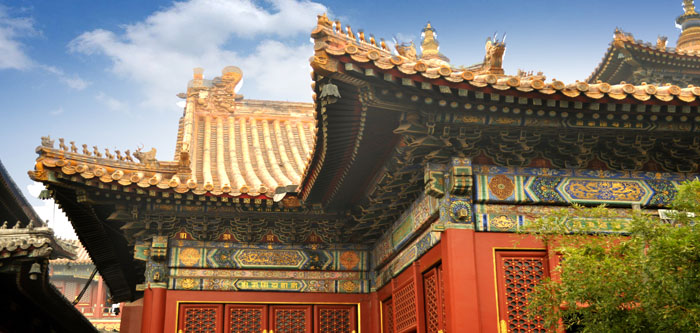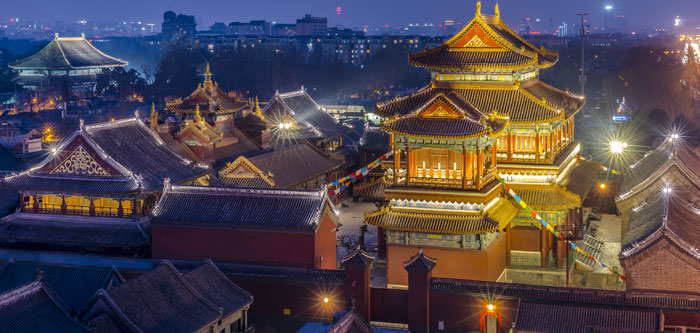Lama Temple - The Most Renowned Temple Outside Tibet
The Lama Temple is also known as the Yonghe Temple. It was a famous Buddhist center where a large number of monks from Mongolia and Tibet converged in the Qing Dynasty (1644–1912). Before it was famous for being a monastery of the Gelug school of Tibetan Buddhism, it originally served as the residence of Yinzhen (the fourth son of Emperor Kangxi). Compared with other temples, this ornate yellow (a color only used by emperors) temple has a perfect blend of Tibetan and Han cultures.
Features
- The Lama Temple is a significant historic site, which was not only a Buddhist center but also the residence of Prince Yong.
- Explore just one temple to uncover the mysterious mask of both Han and Tibetan building cultures.
- Explore Chinese Buddhist culture by visiting the most renowned temple outside Tibet.
Architectural Highlights of the Lama Temple
The Lama Temple is one of the largest Buddhist temples in China, covering an area of 6.6 hectares and containing 661 rooms. There are five main halls in the Lama Temple, which are arranged along a 480-meter-long north-south central axis. 
The Hall of Harmony and Peace
The Hall of Harmony and Peace was a palace where Prince Yong met officials. After he inherited the throne in 1722, it was rebuilt as the main hall of the Lama Temple. There are three bronze Buddhist statues of the Three Ages: Gautama Buddha, Kasyapa Matanga, and Maitreya Buddha. The three Buddhas represent three ages respectively: the present, the past, and the future. It also shows that Buddha is everywhere and forever.
The Gate of Harmony and Peace
The Gate of Harmony and Peace is located between two inscriptions and is the main entrance to this exceptional Lama Temple. A cheerful and topless Maitreya statue is sitting on the middle dragon throne and the four Heavenly Kings are sitting on both sides of the hall. They are all stepping on the feet of ghosts to show that they want to punish evil and keep the world peaceful.
The Hall of Everlasting Protection
The Hall of Everlasting Protection was the study and living room for Prince Yong. After he died, his coffin was placed there; then it became a holy hall to bless the souls of late emperors. Seen from outside, it looks like five separate rooms, although it is a complete building consisting of five rooms. A 2.35-meter-tall statue of Amitabha stands in the middle of this hall.
The Hall of the Wheel of the Law
The Hall of the Wheel of the Law is the fourth hall you reach from the entrance. It has a perfect blend of Tibetan and Han culture. Today, it is a hall for Buddhists to read scriptures and hold religious ceremonies. It is a magnificent sculpture that was built in 1924 with the construction lasting for 2 years. In the middle of the hall is a 6.1-meter-high statue of the founder of the Gelug school of Tibetan Buddhism — Je Tsongkhapa.
The Pavilion of Ten Thousand Happinesses
The Pavilion of Ten Thousand Happinesses is the fifth hall from the entrance. It is 25 meters tall and people regarded it as a heavenly palace because of its height. There is a majestic Maitreya Buddha statue. It is 18 meters tall, 8 meters wide, and was sculpted from a precious single block of sandalwood.
Top Glittering Artworks of the Lama Temple
Wonderful artworks are another highlight of the Lama Temple. They fully embody the Tibetan and Han cultures: riveting yellow roofs, fabulous statues, luxurious decorated arches, and amazingly impressive carpentry. 
Five Hundred Arhats Mountain
Location: the Hall of the Wheel of the Law Features:
- The whole mountain was carved from rosewood.
- There are 500 arhats made of gold, silver, copper, iron, and tin.
- They are vivid and interesting: some of them are teaching Buddhism; some of them are subduing the dragon and taming the tiger (to display they can overcome strong enemies); some of them are sitting or lying; and some of them are meditating or drinking wine.
Sandalwood Buddha
Location: the Pavilion of Ten Thousand Happinesses Features:
- It was carved from the main trunk of a sandalwood tree.
- It is 26 meters high and weighs 100 tons.
- It is the largest wooden figurine in China that was carved from one tree.
Buddhism Activities
Good Wishes Day
Good Wishes Day is an important festival of the Gelug school of Tibetan Buddhism. It was a ceremony to memorize Sakyamuni and purify Buddhism in the Jokhang Temple, held since 1409. By the end of Emperor Kangxi's reign, the activity had spread to Beijing and was supported by the Qing government. Since then, the Lama Temple also celebrated Good Wishes Day annually on 23rd day of the first month of the Chinese lunar calendar.
Puja to Celebrate New Year's Day
The first day of the first month of the Chinese lunar calendar marks the beginning of the new year. In the Qing Dynasty (1644–1912), when the new year arrived, 36 monks were selected from the Lama Temple to chant scripture to welcome the new year. They wanted to pray for a peaceful world and good harvests. On this day each year, a lot of people pray, burn incense, and turn scriptures in the Lama Temple.
Exorcism Dance
The exorcism dance is a religious dance based on a local Tibetan dance and it has a perfect fusion of Indian yoga. The monks hope to keep Buddhism flourishing and the world peaceful by dancing. The dancers wear a special religious mask when they perform, following the beat of drums and cymbals. In fact, exorcism by dancing is implied to drive evil from the heart. Buddhism states that people would otherwise indulge in evil ideas and it would be painful.
Travel Tips
Location
The Lama Temple is located at 12 Yonghegong Street, Beixinqiao, Dongcheng District, Beijing. It's about 5 kilometers away from Tian'anmen Square. 
Opening Times
Winter: November 1 to March 31 — 9am to 4pm Summer: April 1 to October 31 — 9am to 4:30pm
Transportation
- By Bus:
- Take bus 13 or 684, and get off at Imperial College Station.
- Take bus 116 or 117, and get off at Yonghegong Station.
- Take bus 2, 18, 44, 62, 606, 800, 858, or 909, and get off at Yonghegong East Bridge Station.
- By Subway:
- Take subway line 2 or line 5, and get off at Yonghegong Station.
